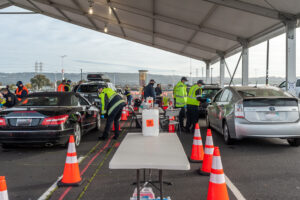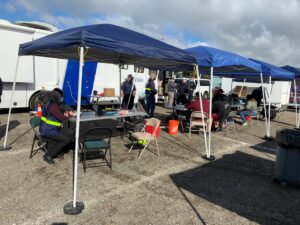SACRAMENTO — On Feb. 3, the Biden-Harris Administration and California Governor Gavin Newsom announced an eight-week federal pilot project to establish Community Vaccination Centers (CVCs) in Oakland and Los Angeles — the first state-run, federally supported centers in the nation focused on vaccinating underserved communities and those most affected by COVID-19.
The pilot CVC mission employed a whole-of-community approach, with more than 1,600 staff from the California Governor’s Office of Emergency Services, California Department of Public Health, California National Guard, California Department of Forestry and Fire Protection, Federal Emergency Management Agency (FEMA), U.S. Department of Health and Human Services, U.S. Department of Defense, U.S. Forest Service and many more.
The private sector played a significant role, too, including local retailers, the American Red Cross, and a collection of interpreters who translated vaccination information for thousands in Cantonese, Korean, Mandarin, Spanish, Tagalog, Vietnamese, Portuguese, Taishanese, and American Sign Language.
 The team also included 108 Californians hired by FEMA to perform various duties as assigned. By hiring local employees, FEMA gains valuable community insights, provides jobs, and allows Californians to assist in their state’s response to the COVID-19 pandemic. Each center relied on help from about 50 government and non-government partners every day.
The team also included 108 Californians hired by FEMA to perform various duties as assigned. By hiring local employees, FEMA gains valuable community insights, provides jobs, and allows Californians to assist in their state’s response to the COVID-19 pandemic. Each center relied on help from about 50 government and non-government partners every day.
Under the federal-state banner, the CVCs, each with three Mobile Vaccination Clinics (MVCs), boosted California’s vaccination rate and
helped fill the gap while supplies increased. When the CVCs were established, the state was receiving roughly 1.5 million vaccine doses a week. Moving forward, California is scheduled to receive at least 2 million doses a week. Additionally, pharmacies are scheduled to get an increase of 500,000 vaccines per week.
The two CVCs created a framework for expanding California’s ability to provide a vaccine to every person who wants one. As of April 11, the eight-week pilot program surpassed expectations by administering more than 720,000 doses.
Lessons learned
A key strategy to the CVC’s success was creating multiple methods to access the vaccine. The CVCs, both located near public transit, offer drive-thru, walk-thru, and mobile vaccination options to address the diverse needs of their perspective communities. Drive-thru offers convenience, social distancing, and speed. Walk-thru is also speedy and convenient for those who arrive via public transit, bicycles, or on foot. MVCs bring vaccine services directly into the community, benefiting people who have a harder time getting to the CVC.
The pilot mission also implemented “trusted messengers,” community leaders who helped share accurate vaccine information, facilitate community outreach, and drive participation in vaccination events in an effort to overcome general vaccine hesitancy.
 Each MVC event was hosted by a community or faith-based organization to microtarget the hardest-hit and hardest-to-reach communities. One of those Community Based Organizations was La Familia, a longtime East Bay social services agency that hosted several MVC events reaching Hispanic, Native American, Pacific Islander, Afghan, and other communities.
Each MVC event was hosted by a community or faith-based organization to microtarget the hardest-hit and hardest-to-reach communities. One of those Community Based Organizations was La Familia, a longtime East Bay social services agency that hosted several MVC events reaching Hispanic, Native American, Pacific Islander, Afghan, and other communities.
“Without the MVCs, these vaccines would never have gone to these people. At our events, about 9,000 people who probably wouldn’t have been vaccinated have gotten shots. Our staff got so many thank-yous. We had people walking away crying and thanking us. Some teachers who teach and live in the community gave us donations on the spot,” said Aaron Ortiz, CEO of La Familia. “What this pandemic has shown is we don’t belong to ourselves — we belong to each other,” he said.
The success has been measurable. MVCs consistently administered all their daily vaccine allocations, with 67 percent administered to underserved communities and people of color.
Local management with state and FEMA support
The pilot phase has demonstrated the effectiveness of CVCs and their innovative methods of connecting with people. To continue serving these communities, the state and FEMA have coordinated with local officials to keep the two vaccination centers open. The city of Los Angeles has agreed to manage the Los Angeles operation, while Alameda County and Contra Costa County will run the Oakland CVC, with the full transition starting Apr. 12.
Going forward, FEMA and its federal partners will remain involved. The agency is prepared to leave all locally-hired FEMA employees and the three MVCs at each site, while continuing to cover 100 percent of all costs associated with each CVC through September. But it cannot provide CVC vaccine allocations, which equal only a small percentage of vaccines now available in the state.
The goal remains to assist, augment and expedite the work of local communities to provide life-saving vaccines to underserved individuals and communities disproportionately impacted by COVID-19, including essential workers whose efforts have kept the economy open over the past year.
###

